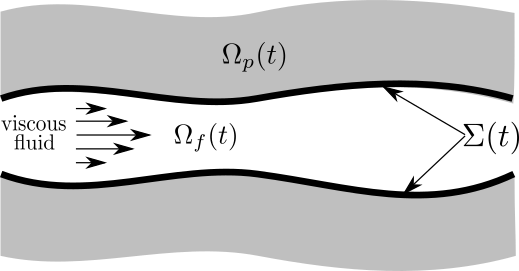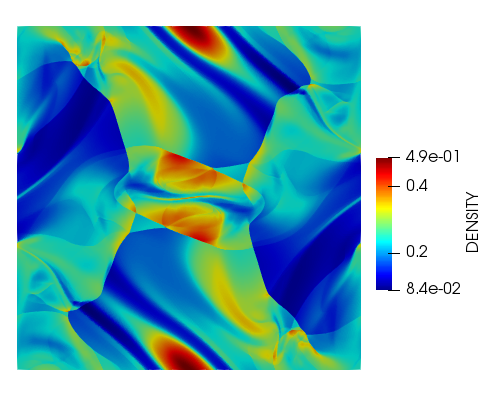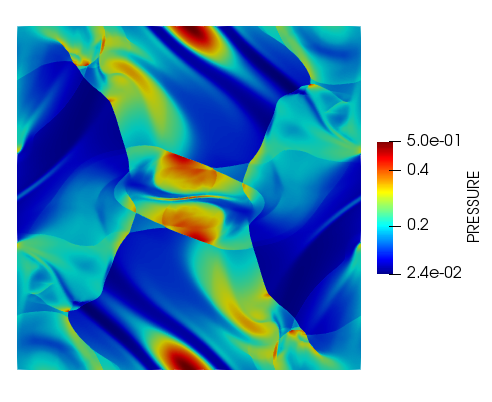Sibusiso Mabuza
RESEARCH
Reactive transport in visco-poro-elastic media
We propose a model for fully coupled solvent-solute
dynamics in a fluid-multilayer structured medium. A Newtonian fluid in which
reactive solutes are dissolved is considered. The solution
enters an open channel and transport dynamics occur in the open channel, on the thin channel
walls as well as in the surrounding thick poro-elastic media.
We assume that the solutes directly affect the physical properties of
the viscous fluid, the thin semi-permeable membrane, or the
the poroelastic structure. We thus get a fully coupled model for chemical solutions, which are
transported to the surrounding tissue material, and undergoing reactions in the tissue.
The solution in the open channel \(\Omega_f(t)\) is
modeled by convection-diffusion-reaction equations coupled with the Navier-Stokes equations.
The dynamics of the solutes and the fluid across the selectively permeable membrane \(\Sigma(t)\) are
defined by the Kedem-Katchalsky (KK) equations. The KK models have been
studied for chemical solutes moving across arterial walls.
In the poroelastic structure \(\Omega_p(t)\) the chemical solutes
are modelled by a reaction-diffusion equation. Robust monolithic solvers
are considered for this problem, making use of fail-proof property preserving
methods. High order implicit-explicit time integrators are considered
and various nonlinear solvers with algebraic preconditioners are explored.
Resistive viscous magnetohydrodynamics
High resolution shock capturing finite element schemes are studied
for the viscous resistive magnetohydrodynamics system. These equations
are a coupled system of conservation laws for modeling plasma flows.
They describe the interaction between magnetic fields and conducting fluids.
A high order finite element discretization of these equations is
being implemented with robust property preserving stabilization.
Suitable divergence cleaning is used to control the
\(\nabla \cdot \mathbf B\) error. High order \(H^1\) conforming finite element
bases such as B-spline discretization are considered in order
to achive high order spatial convergence. Implicit high-order strong stability
preserving temporal discretization is also considered.
Multifluid plasma
In this project, we consider a general multifluid model based on the kinetic equations.
This model is composed of three groups of equations: the continuity, momentum,
and energy equations for each fluid species. The source terms for each equation
are written in a general form for either an electron species or an arbitrary atomic
species. In order to avoid repetition, only the most general form of each source
term is provided for the atomic species. This is done with the understanding that
not all ionization and recombination terms will be present for each species; ie.,
neutral atoms do not recombine and ions of the maximum charge state
for a species do not further ionize, though the corresponding source terms are
included in the description of the general source terms. We study various
numerical methods for solving this highly coupled multi-physics problem.
The methods must be physical property preserving, and take into account
widely varying timescales.
PUBLICATIONS
- S. Badia, J. Bonilla, S. Mabuza, and J.N. Shadid, “On differentiable local bounds preserving stabilization for Euler equations,” Comput. Methods Appl. Mech. Engrg., 370, 113267 (2020)
- S. Mabuza, J.N. Shadid, E.C. Cyr, R.P. Pawlowski, D. Kuzmin, “A linearity preserving nodal variation limiting algorithm for continuous Galerkin discretization of MHD equations,” J. Comput. Phys, 410, 109390 (2020)
- S. Mabuza, J.N. Shadid, D. Kuzmin, “Local bounds preserving stabilization for continuous Galerkin discretization of hyperbolic systems,” J. Comput. Phys., 361, 82-110 (2018)
- C. Lohmann, D. Kuzmin, J.N. Shadid, S. Mabuza, “Flux-corrected transport algorithms for continuous Galerkin methods based on high order Bernstein finite elements,” J. Comput. Phys., 344, 151-186 (2017)
- S. Mabuza, S. Canic, B. Muha, “Modeling and analysis of reactive solute transport in deformable channels with wall adsorption-desorption,” Math. Meth. Appl. Sci., 39 (7), 1780-1802 (2016)
- S. Mabuza, D. Kuzmin, “A nonlinear ALE-FCT scheme for reactive transport in moving domains,” Int. J. Numer. Methods Fluids, 76, 875-908 (2014)
- S. Mabuza, D. Kuzmin, S. Canic, M. Bukac, “A conservative, positivity preserving scheme for reactive solute transport problems in moving domains,” J. Comput. Phys., 276, 563-595 (2014)



